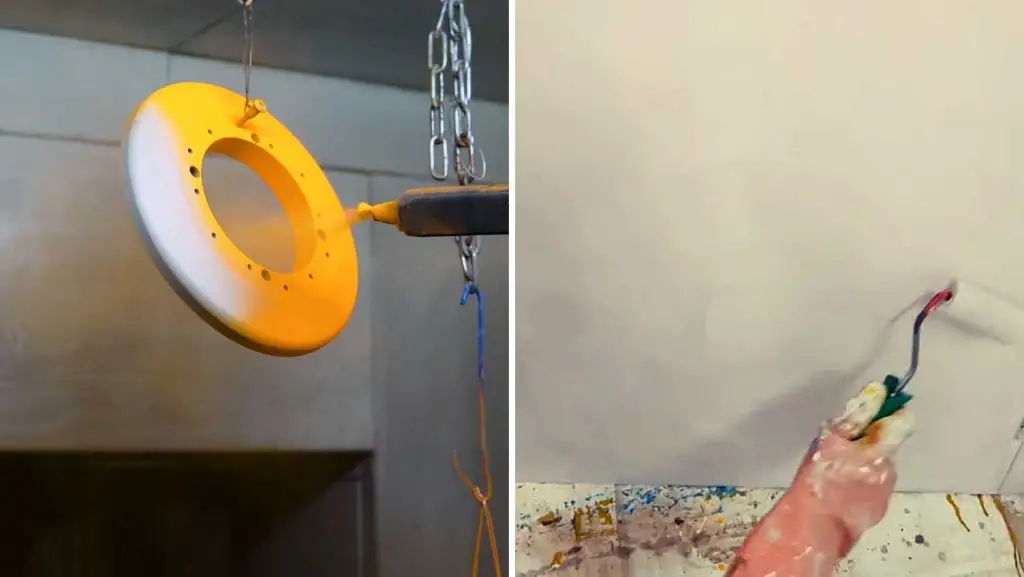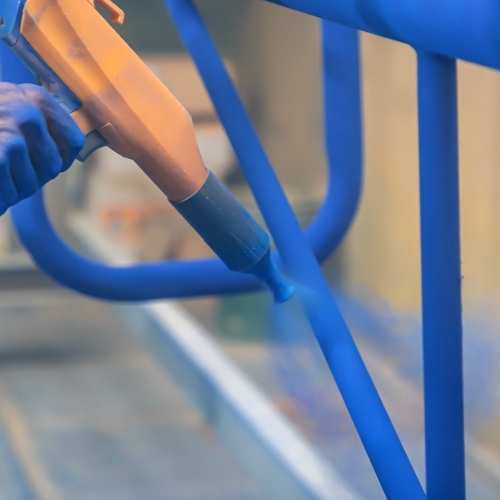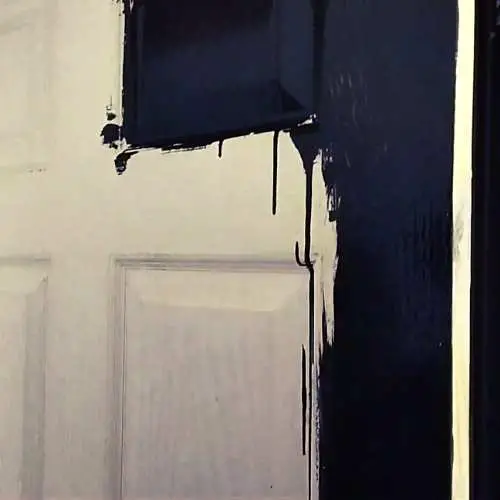Painting or coating the metal surfaces of automotive parts is vital to protecting them from corrosion and other environmental damage. The most common methods for doing this are powder coating and enamel paint. But what’s the difference between these two methods?
Powder coating is a type of painting that uses dry, powdered paint instead of wet paint. The powder is sprayed onto the metal surface and then cured, or baked, to create a durable finish. On the other hand, enamel paint is a type of paint that uses liquid paint instead of powder.
Both powder coat and enamel paint have their pros and cons, so it can be tough to decide which one is right for you. We’ve compiled a list of the key aspects of powder coating and enamel paint to help you make an informed decision.

Here Is How Powder Coat Vs Enamel Paint Differ
Powder coating and enamel paints are two popular methods of protecting metal surfaces from corrosion. Both techniques involve the application of a thick, protective layer that can withstand exposure to the elements. There are some key differences between the two processes:
Composition
Powder coatings are made up of finely ground particles of resin that are electrically charged and then sprayed onto the surface to be coated. The charged particles adhere to the surface and are cured under high heat to create a solid film.
Enamel paint comprises a resin, typically polyurethane, and a hardener. The hardener reacts with the resin to create a cross-linked structure that is strong and durable.
Powder coatings do not contain any volatile organic compounds (VOCs). VOCs are released into the atmosphere as the paint dries and can have negative environmental impacts. Powder coatings are typically thicker than enamel paints, providing better wear resistance and greater protection from chipping and scratching.
In addition, enamel paint generally requires more frequent reapplication than powder coating to maintain its protective properties. As a result, powder coating is often the preferred option for applications where durability is critical.
Application
Enamel paint is typically applied with a brush or roller, while a powder coat is sprayed on. This means that powder coat tends to be much thicker than enamel paint, resulting in a more durable finish.
Powder coat also has better color retention and UV resistance than enamel paint, making it a good choice for outdoor applications. However, powder coat is more difficult to apply than enamel paint, so it is not always the best choice for do-it-yourself projects.

When deciding between powder coat and enamel paint, consider the finished product’s intended use.
Cure time
Powder coatings cure faster than enamel paint. They are usually cured in less than 10 to 15 minutes (around 200°C), while enamel paints can take up to 24 hours to fully cure. This is because powder coatings are cured by exposure to high heat, while enamel paints rely on air drying and evaporation.
This makes powder coatings the ideal choice for projects where time is of the essence. However, it should be noted that not all powder coatings are created equal. Some formulas may require a longer cure time than others. Consult the manufacturer’s instructions to determine the cure time for your specific powder coating formula.
Durability
Another key difference between powder coatings and enamel paints is that powder coatings are much more durable. They are more resistant to chipping, scratching, and fading.
On the other hand, enamel paints are more susceptible to these kinds of damage. This is because powder coatings form a harder shell when cured, while enamel paints do not. In general, powder coatings will last longer than enamel paints.
Finish
The final look of powder coat and enamel paint is where these two types of finishes differ the most. Enamel paint has a more glossy, smooth finish, while powder coatings have more of a matte finish.
Powder coating produces a matte finish because it does not contain any solvents, unlike enamel paint, which does. The absence of solvents results in a less glossy, smooth finish.
Additionally, powder coating is thicker than enamel paint and often requires more coats to achieve the desired look. However, the thicker layer of powder coating provides a more durable finish that is less likely to chip or scratch.
Cost
Powder coating is typically more expensive than enamel paint, both in terms of the materials and the equipment required. For instance, powder coating requires an electrostatic sprayer, which can be a significant investment. And powder coating powder itself is generally more expensive than enamel paint.
However, powder coating can provide several advantages in terms of cost-effectiveness. It is highly durable, so it doesn’t need to be reapplied as often.
Safety
One of the main differences between powder coating and enamel paint is the level of safety involved in each process.
Powder coating is significantly safer than enamel paint, as it does not require the use of any volatile organic compounds (VOCs). This means that there is no risk of inhaling harmful fumes and that the powder coating process can be carried out in well-ventilated areas.

Enamel paint relies on VOCs to help the paint adhere to surfaces. This can result in various health problems, including headaches, dizziness, and respiratory irritation. In some cases, prolonged exposure to VOCs has been linked to cancer. As such, powder coating is the clear choice for anyone looking for a safe and healthy painting option.
What Are the Pros and Cons of Powder Coating?
The following are some of the key advantages and disadvantages of powder coating:
Advantages of Powder Coating
Powder coating is a type of coating that is applied as a dry powder. The powder is usually a thermoplastic or a thermoset polymer. It is applied to the surface of the metal part to be coated. The part is then placed in an oven, where it melts and flows, resulting in a smooth, consistent finish.
Compared to enamel paint, powder coating has a few advantages. The finish is also more consistent, and color retention is better. Powder coating is also more environmentally friendly than enamel finishes because no volatile organic compounds (VOCs) are emitted during the curing process.
Disadvantages of Powder Coating
There are also some potential drawbacks to consider before deciding whether powder coating is the right option for your project.
One of the main disadvantages of powder coating is that it can break down when exposed to UV rays, making it unsuitable for outdoor applications. And because powder coating is applied electrostatically, achieving an even color across the entire surface can be challenging. Touch-ups are also generally more challenging with powder coating than with liquid paints.
Another potential downside is that powder coating requires special equipment, including an oven, spray gun, and booth, which can add to the project’s overall cost. Finally, powder coating must be baked to set properly, which can give you less control over the final finish.
What Are the Pros and Cons of Enamel Paint?
Now that we’ve looked at both sides of powder coating, let’s take a closer look at enamel paint.
Advantages of Enamel Paint
One advantage of enamel paint is that it provides a glossy finish. When the paint dries, it leaves behind a lustrous sheen. This can give the surface an elegant look. The glossy finish can also make it easier to clean the surface since dirt and grime will not adhere to it as easily.
Another benefit of enamel paint is that it gives a uniform finished surface. Unlike other types of paints, enamel paints tend to dry evenly and without streaks or brush strokes. This can give the surface a professional appearance.
Enamel paint is also very easy on any surface. It does not require a primer or undercoat, so it can save you time and money when painting. It also provides a hard surface. Once it dries, it forms a durable barrier that is resistant to scratches, scuffs, and stains. This makes it ideal for high-traffic areas like kitchens and bathrooms.
Disadvantages of Enamel Paint
Enamel paint does have a few drawbacks that should be considered before using it.
Firstly, enamel paint is susceptible to scratches and other damage if it is of low quality.
Secondly, enamel paint can shrink more than other types of paint, accentuating any imperfections in the surface beneath. For these reasons, it is important to weigh the pros and cons of using enamel paint before deciding.
Finally, enamel paint generally has a strong odor due to its emitting VOCs. This can be a problem for people with asthma or other respiratory conditions. It is also important to ventilate the area well when using enamel paint, as the fumes can be harmful.
What’s the Process of Powder Coating Paint?
You’ll need to clean it with a pre-paint prep and ensure no grease or other contaminants will prevent the powder from adhering. Once your part is clean, you can attach the powder bottle to the gun and connect the airline.
Make sure your air pressure is set between 5 and 10 PSI. When you’re ready to start painting, hold the gun about 8-10 inches from the part’s surface and pull the trigger. The powder will flow out and stick to the part.
Once you’ve got an even coat, you can put the part in an oven to cure the powder. The exact cure temperature will depend on the powder you’re using, so consult the manufacturer’s instructions. Curing usually takes up to 15 minutes. And that’s all there is to it. Powder coating is a great way to get a durable, long-lasting finish on metal parts.
How Do You Enamel Paint?
Enamel paint is a popular choice for furniture because it’s durable and has a high gloss finish. However, before you start painting, removing any dust from the furniture’s surface is important.
Otherwise, the paint won’t adhere properly. Once the surface is clean, you can start painting with even strokes. Don’t soak the brush in too much paint, or else you’ll have a messy finish.
After applying the coat, let it dry for a week before using the piece of furniture. With proper care, your enamel-painted furniture will last for years to come.
What Materials Cannot Be Powder Coated?
- Wood is tricky to powder coat for two reasons: first that it isn’t always able to handle high temperatures, and second, it isn’t always electrically conductive.
- Glass can also be difficult to powder coat because it doesn’t always adhere well to the surface.
- Plastics can be powder coated, but only certain types, generally those with a high melting point.
- Fabric can be powder coated as well, but again, only certain types; usually, synthetic fabrics work best.
- Finally, items without a charge can’t be powder coated because the process relies on electrical charges to attract the powder to the item being coated.
Do You Powder Coat Over an Existing Finish?
Applying powder coating over an existing paint can often be done, but you should know a few things before attempting it.
First, the quality of the existing paint job will affect how well the powder coating adheres. If the paint is in poor condition, it’s likely that the powder coating will not adhere well and could begin to peel.
Second, the type of paint used will also affect whether or not you can powder coat over it. Some types of paint, such as water-based paints, are incompatible with powder coating.
Finally, you’ll need to take steps to ensure that the surface is clean and free of any contaminants before applying the powder coating. If all of these factors are considered, you should be able to apply a powder coat over an existing paint job with no problems.
Frequently Asked Questions
While you have a general understanding of powder coating vs enamel paint, you might still have some questions. Here are answers to some common questions about these two finishes.
Does Powder Coat Last Longer Than Enamel Paint?
Powder coating is more durable and can be applied thicker in one coat, but it is also more expensive. Enamel paint is less expensive, but it does not last as long and does not provide as much protection from corrosion. Ultimately, the decision of which to use will depend on the project’s specific needs.
Can I Do Powder Coating Myself?
While it is certainly possible to powder coat your own belongings at home, it is important to be aware of the expense involved in setting up the necessary equipment and supplies. It is probably the curing oven, which can be very expensive.
In addition, you will need to purchase powder coating guns and other equipment, as well as a variety of powders in different colors. As a result, powder coating at home is generally not a viable option for those looking to save money.
Which Is Better Acrylic or Enamel Paint?
There are pros and cons to both acrylic and enamel paint. Enamel paint is more durable and resists fading, but it can be more brittle and is not as flexible as acrylic paint. It is not the best option for painting outdoors, as it may crack in colder or hotter weather.
Acrylic paint is more flexible and can withstand temperature changes. It is also less likely to crack or chip. However, it may not last as long as enamel paint and may fade over time.
Conclusion
So, there you have it, a comprehensive guide to powder coating vs enamel paint. As you can see, there are pros and cons to each type of finish.
Powder coating is the way to go if you need a durable, long-lasting finish. However, if you are on a budget or working on a project that does not require a high level of durability, enamel paint may be the better option.
Whichever type of finish you choose, consider all the factors involved to make the most informed decision for your project. And, if you’re still unsure, consult a professional to get the correct advice for your specific project.

S. Pushon is a paint expert, self-taught artist, and currently working as an adviser in the paint industry as a Quality Improvement and Development Assistant.
An artist by heart, he draws remarkable art pieces and as a professional paint industry individual, he seeks the insight and shares with enthusiasts. Read more…
